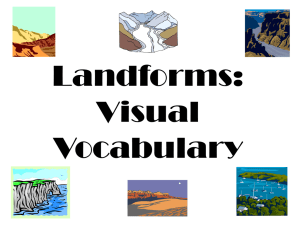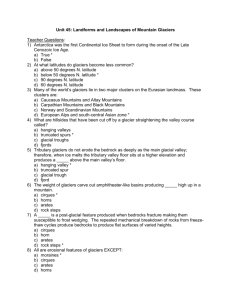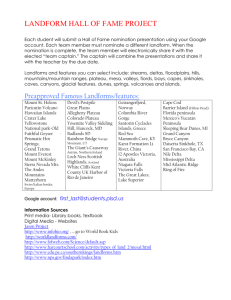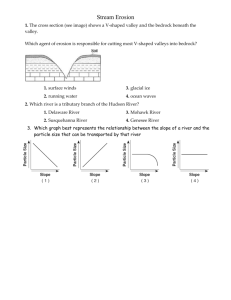GEOL_553_lab_03_hand..
advertisement
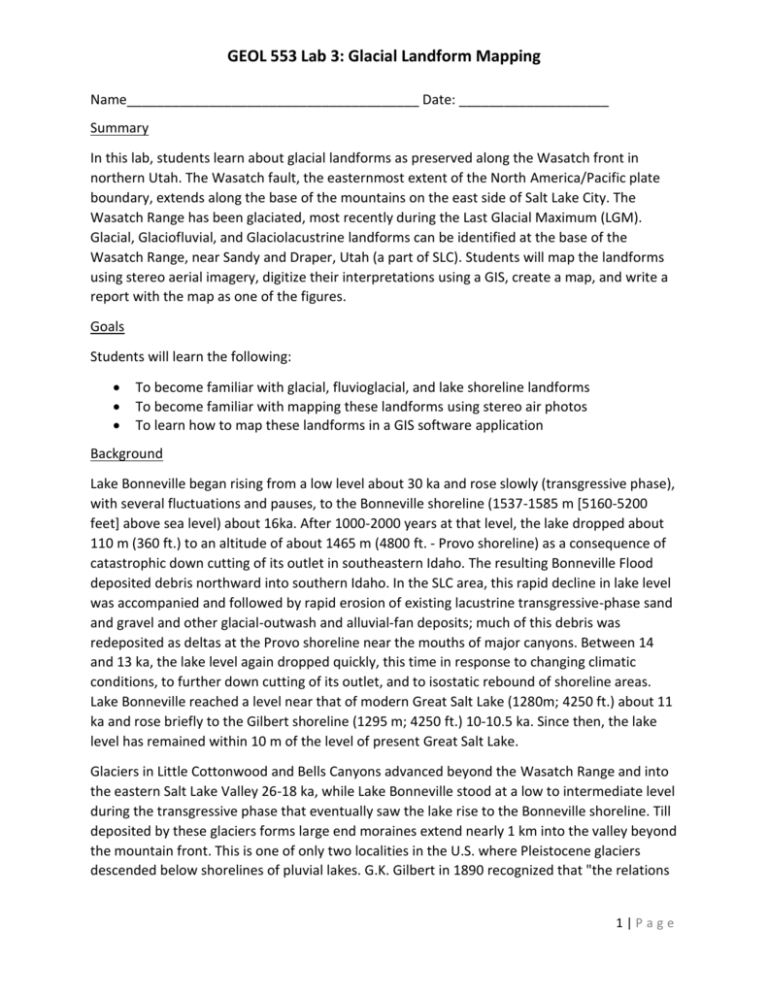
GEOL 553 Lab 3: Glacial Landform Mapping Name_______________________________________ Date: ____________________ Summary In this lab, students learn about glacial landforms as preserved along the Wasatch front in northern Utah. The Wasatch fault, the easternmost extent of the North America/Pacific plate boundary, extends along the base of the mountains on the east side of Salt Lake City. The Wasatch Range has been glaciated, most recently during the Last Glacial Maximum (LGM). Glacial, Glaciofluvial, and Glaciolacustrine landforms can be identified at the base of the Wasatch Range, near Sandy and Draper, Utah (a part of SLC). Students will map the landforms using stereo aerial imagery, digitize their interpretations using a GIS, create a map, and write a report with the map as one of the figures. Goals Students will learn the following: To become familiar with glacial, fluvioglacial, and lake shoreline landforms To become familiar with mapping these landforms using stereo air photos To learn how to map these landforms in a GIS software application Background Lake Bonneville began rising from a low level about 30 ka and rose slowly (transgressive phase), with several fluctuations and pauses, to the Bonneville shoreline (1537-1585 m [5160-5200 feet] above sea level) about 16ka. After 1000-2000 years at that level, the lake dropped about 110 m (360 ft.) to an altitude of about 1465 m (4800 ft. - Provo shoreline) as a consequence of catastrophic down cutting of its outlet in southeastern Idaho. The resulting Bonneville Flood deposited debris northward into southern Idaho. In the SLC area, this rapid decline in lake level was accompanied and followed by rapid erosion of existing lacustrine transgressive-phase sand and gravel and other glacial-outwash and alluvial-fan deposits; much of this debris was redeposited as deltas at the Provo shoreline near the mouths of major canyons. Between 14 and 13 ka, the lake level again dropped quickly, this time in response to changing climatic conditions, to further down cutting of its outlet, and to isostatic rebound of shoreline areas. Lake Bonneville reached a level near that of modern Great Salt Lake (1280m; 4250 ft.) about 11 ka and rose briefly to the Gilbert shoreline (1295 m; 4250 ft.) 10-10.5 ka. Since then, the lake level has remained within 10 m of the level of present Great Salt Lake. Glaciers in Little Cottonwood and Bells Canyons advanced beyond the Wasatch Range and into the eastern Salt Lake Valley 26-18 ka, while Lake Bonneville stood at a low to intermediate level during the transgressive phase that eventually saw the lake rise to the Bonneville shoreline. Till deposited by these glaciers forms large end moraines extend nearly 1 km into the valley beyond the mountain front. This is one of only two localities in the U.S. where Pleistocene glaciers descended below shorelines of pluvial lakes. G.K. Gilbert in 1890 recognized that "the relations 1|Page GEOL 553 Lab 3: Glacial Landform Mapping of these moraines to the shores of the lakes and the associated deposits indicate that the maximum stage of the lakes coincided closely with the epoch of maximum glaciation." Meltwater from these glaciers and from glaciers in Big Cottonwood Canyon deposited gravelly outwash fans along the range front and deltaic deposits in Lake Bonneville. Other streams, emanating from valleys in the Wasatch Range whose headwaters were at altitudes too low to support more than small glaciers, also deposited gravelly fans and deltas graded to the lake. The rising lake culminated at the Bonneville shoreline about 16 ka, several thousand years after the glaciers in Little Cottonwood and Bells Canyons had retreated some distance up-valley from their end moraines. The outwash and alluvial-fan deposits along the mountain front also were inundated by the rising lake and, except for small areas near the canyon mouths that stood above the level of the lake, are covered by a veneer of lake sediment. The combined outwashfan-and-delta complexes form the highest surfaces along the range front. Note the time lag between retreat of the glaciers up-valley and the maximum lake level. The rise and fall of Lake Bonneville is not a simple matter of glacial ice melting and filling the lake. In fact, the volume of water in the glaciers is not enough to account for the volume of water in the lake. Climate is a large factor. Interglacial periods are warm, so there is more evaporation, but also more precipitation. Glacial periods are the opposite. Much of the gravel mined along the range front represents classic Gilbert-type deltas built at and below the Provo shoreline near the mouths of major canyons in the initial phases of the regressive phase. Straths cut at this time can be seen on the south side of Big Cottonwood Creek. The long, steep foresets of these deltas were at one time visible in a few of the pits. The great bulk of deposits at the Provo shoreline is due to the large volume of sediments in the high-shore zone at the mouths of major streams that were available for erosion and redeposition following the rapid lake-level change. As the level of Lake Bonneville receded from the Provo shoreline during the regressive phase, alluvial-fan deposits and debris-flow deposits were emplaced at canyon mouths along the mountain front. Rates of alluvial-fan deposition appear to have declined later in the Holocene, because deposits of late Holocene age are restricted to small deposits covering parts of the surfaces of much larger alluvial fans. Pre-Bonneville-lake-cycle deposits are limited to small remnants of alluvial-fan and glacial-drift deposits. Till of the Dry Creek advance is exposed at the mouths of Little Cottonwood and Bells Canyons. Till is weathered to a degree that suggests an age of about 150 ka, correlating with Bull Lake-aged moraines in the Rocky Mountains. Outwash of probably the same age is exposed in gravel pits near the mouth of Big Cottonwood Canyon and along Dry Creek downstream from Bells Canyon. 2|Page GEOL 553 Lab 3: Glacial Landform Mapping Figure 1. Landforms and deposits associated with continental glaciers. 3|Page GEOL 553 Lab 3: Glacial Landform Mapping Figure 2. Landforms and deposits associated with alpine glaciers. Depositional Landforms As ice melts it leaves behind the sediment carried within it. This sediment can be piled around the edges or beneath a glacier as it melts, or the sediment can be directly deposited beneath active, moving ice. Subsequent advances of a glacier can rework and destroy landforms created by previous advances. Glacial depositional features include: • Moraines. The debris deposited directly from the glacial ice is called moraine. Terminal moraines are deposited at the leading edge of a glacier, lateral moraines are deposited at the sides of a glacier, and ground moraine is deposited beneath the glacial ice. Medial moraines may form where two glaciers flow together, sandwiching their lateral moraines within the new, combined glacier. • Drumlins. Streamlined hills formed in sediment or bedrock that form beneath glaciers. Drumlins are elongated in the direction of ice motion with steep faces pointed uphill. • Outwash plains. Much of the finer sediment may be washed away from a glacier by meltwater. The meltwater deposits this sediment over a broad outwash plain. • Kettles. Blocks of ice may be isolated from the main glacier as it recedes and become surrounded and covered with moraine or outwash sediment. As the block melts, the overlying sediments collapse, leaving a depression called a kettle. 4|Page GEOL 553 Lab 3: Glacial Landform Mapping • Eskers. Streams flowing on, within, or below glaciers can deposit ribbons of channel sediment just like those flowing in channels within bedrock. When the ice melts, these ribbons of sediment are left behind as ridges called eskers. Glacial Sediments Sedimentary deposits left by glaciers are highly variable in terms of their sorting and grain size. Common deposits found in glacial and near-glacial environments include: • Till. This is sediment deposited directly from the ice. Moraines consist of till. Till is typically very poorly sorted and has angular grains. There is typically no bedding in tills. Often, continental tills have a bimodal grain size, with a fine-grained matrix and larger clasts. (The non-genetic term for bimodal sediment is diamict.) • Stratified drift. This is a catch-all term for glacial sediments that have been somewhat reworked by water. This kind of deposit is common along ice margins where sediment is released from the ice and moved by meltwater. It is often poorly sorted with pockets or lenses of well-sorted sand. • Glaciofluvial deposits (outwash). Meltwater streams can re-work sediment deposited by the glacier. These streams are often steep, have very high sediment loads, and are braided instead of meandering. Outwash deposits are typically better sorted than tills, as the finest grains have been washed away, leaving cross-bedded sub-rounded to well- rounded sand, gravel, and cobble-sized clasts. Outwash develops in front of advancing and retreating glaciers. The size of the sediment can be a function of the proximity of the glacier, with larger clasts remaining closer to the glacier. • Glaciolacustrine deposits. Glaciers can block streams and create pro-glacial lakes. Sediment carried into these lakes settles on the bottom. Typically, the coarse-grained sediment settles near the edges, where streams enter the lake. Fine-grained sediment (silt and clay) can be carried out to the middle of the lake, where it can form very thin layers called laminations. Sometimes, sediment-rich icebergs can carry larger clasts out to the middle of a lake, melt, and drop them into the finer-grained sediment. These large clasts found within finer-grained lake sediments are called dropstones. Glacial Stratigraphy The history of glacial advances and retreats are unraveled through their deposits. Because glacial ice advances and retreats, the type of sediment deposited in a glacial environment is highly dependent upon where the ice is through time. For example, an outwash plain in front of a glacier may get overridden by that glacier, resulting in a layer of outwash capped by a layer of till. Similarly, till left by a retreating glacier may become covered by outwash as the ice retreats. However, because glaciers and the associated streams are very erosive and deposition is often irregular, deposits can have irregular (non-horizontal) contacts and entire layers may be missing. 5|Page GEOL 553 Lab 3: Glacial Landform Mapping Part I. Mapping Glacial/ Glaciofluvial /Glaciolacustrine Landforms Use stereo air photos to map glacial, Glaciofluvial, and Glaciolacustrine landforms at the mouth of Little Cottonwood Canyon. Glaciofluvial landforms include landforms that one would typically map as fluvial landforms. Glaciolacustrine landforms include landforms that one would typically map as lacustrine landforms. The only difference is that these landforms are related to processes related to glaciation and pluvial forcing factors. Trace the different landforms and label them onto your tracing paper. You will use this map as a guide when you digitize the features in the GIS system. Aerial photographs are an important supplement to topographic maps. They provide detailed views of the Earth’s surface and, when viewed stereoscopically (in three dimensions), show subtle topographic features, vegetation patterns, and textural differences, which cannot be expressed simply by contour lines. Vertical aerial photographs are usually taken sequentially along a predetermined flight line (Figure 3A). Photographs are taken frequently, and each photograph includes a portion of the land area shown on the previous picture. Flight lines try to attain approximately 60% photographic overlap. When a portion of the overlap area is viewed through a stereoscope, each eye sees exactly the same area, but at different angles and on different photographs (Figure 3B). The view through the stereoscope approximates that of an observer suspended over the original landscape. As a result, the two photographs merge into one, thereby creating a three-dimensional effect. Figure 3. Diagrams illustrating vertical aerial photography and stereoscopic viewing. (A) The photograph taken over location 1 covers the ground area indicated. The photograph taken over location 2 includes about 60% overlap with the area covered by photograph 1. (B) A stereoscope is used to restore original angular relationships and obtain a three-dimensional view of area of overlap. 6|Page GEOL 553 Lab 3: Glacial Landform Mapping Part II. Digitizing Landforms Use ArcMAP to digitize the landforms that have been mapped using the stereo air photos. Add spatial data including topography, aerial imagery, and topographic imagery to help collocate features found on the air photos with those in the digital GIS space. We may use polyline data sets and/or polygon data sets. A map is a two-dimensional representation of a portion of the Earth’s surface. Most maps used today are planimetric, which convey data on a two-dimensional surface. Planimetric maps may provide information about transportation routes, geographic location, nominal data, vegetation patterns or other forms of data requiring spatial representation. LIDAR (a portmanteau of “light” and “radar”) mapping, also described as Airborne Laser Swath Mapping (ALSM), utilizes an airborne scanning laser rangefinder to produce detailed topographic surveys. This relatively new mapping technique produces more comprehensive and precise topographic data than traditional methods. One of its unique properties is that airborne laser altimeter data can be used to accurately measure topography even when vegetation growth is extensive, such as forested terrains. Accurate topographic data is acquired by precisely timing the round-trip travel time of a pulse of laser light from the airplane to ground surface and back. The travel-time is converted to distance from the ground to the plane knowing that the laser pulse travels at the speed of light. Laser transmitters fire thousands of pulses per second, which provides very detailed distance data of the surface below. The airplane’s location at the time that a given set of laser pulses is emitted is accurately determined using a global positioning system (GPS). The distance measurements and GPS data are then converted to detailed map coordinates and elevation data coincident with individual laser pulses. Large surface areas are mapped by flying many parallel flight lines ensuring that there is adequate overlap for complete coverage. Newer laser technology can measure multiple reflected returns so that vegetation cover can be identified and “removed” from the mapped surface by comparing the multiple returns with the “last return” (inferred to be from the actual ground surface). High resolution LIDAR imagery has many applications important to the geoand environmental sciences, as well as urban and rural planning. For more detailed and complete information regarding LIDAR imagery, techniques and applications refer to the Puget Sound LIDAR Consortium’s web site at: http://pugetsoundlidar.ess.washington.edu Prepare a map using the digitized linework and any combination of other background data that will help locate your line work. On the GIS laboratory computers are loaded the following data sets: Digital Elevation Model (DEM) and shaded relief rasters at 10 m resolution, National Aerial Imagery Program (NAIP) real color imagery at 1 m resolution, USGS Topographic Map Imagery (DRG, Digital Raster Graphic), and LIDAR DEM and shaded relief rasters at 2 m resolution. 7|Page GEOL 553 Lab 3: Glacial Landform Mapping Create shapefiles that can be edited to delineate the different landforms. Create a map with these landforms symbolized for usability, with a legend, a scale bar, a north arrow, and any important notation. Use the different raster data sets at varying levels of transparency to enhance your map. Feel free to make several maps with different combinations of raster base data. Part III. Questions and Report Prepare a report with the map from part II as a figure. The report will include the standard sections (introduction, methods, results, discussion, and conclusion). The report will include answers to the following questions as part of the discussion and conclusions. Questions: What types of landforms were you able to map? Define the landforms and describe how the landforms were created. Is there evidence for different lake levels? If so, what is this evidence and where is it located on your map? Is it Glaciofluvial, Glaciolacustrine, both, or neither? Is there evidence for fluvial landforms that may be related to the evidence for lakes? If so, what is this evidence and where is it located on your map? Is there evidence for receding glaciers? If so, what is this evidence and where is it located on your map? Is there evidence for multiple glaciations? If so, how did you come to this conclusion? Describe the evidence you used to form this conclusion. GIS data sources: LiDAR data (2m) http://gis.utah.gov/data/elevation-terrain-data/2-meter-lidar/ Basics about LiDAR: https://en.wikipedia.org/wiki/Lidar More about LiDAR: http://www.opentopography.org/index.php/resources/education DEM data (10 m) http://gis.utah.gov/data/elevation-terrain-data/10-30-90-meter-elevationmodels-usgs-dems/ USDA Imagery and USGS Topographic Imagery (MrSID) https://gdg.sc.egov.usda.gov/ 8|Page



